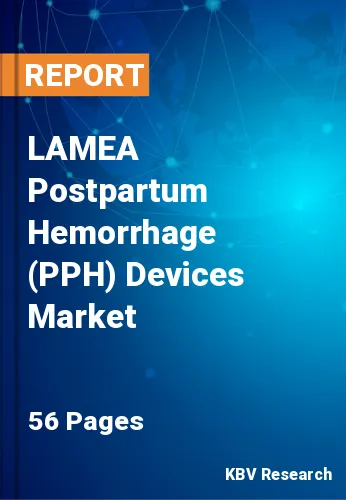
The Latin America, Middle East and Africa Postpartum Hemorrhage (PPH) Devices Market would witness market growth of 7.2% CAGR during the forecast period (2022-2028).
Although there are various distinct types of UBT devices, they always include a balloon, a catheter, and a syringe. The UBT works by inserting a balloon into the uterus and inflating it (typically with sterile water) to restrict blood flow and encourage clotting in the uterine wall. While a UBT can be made from widely available goods (such as gloves, condoms, and Foley catheters), there are also commercially available UBT devices (e.g. Sengstaken-Blakemore or Bakri Balloon). The use of a UBT has shown promise in the management of primary PPH in low-income settings (especially in rural places where resources are limited and transfer to higher-level facilities for invasive surgical intervention (e.g. uterine removal) is challenging. However, the technology is under-researched and under-utilized, and questions about the practicality and acceptability of employing a UBT have not been thoroughly investigated.
In Sub-Saharan Africa, maternal mortality ranges from 500 to 1000 per 100,000 newborns (vs. approximately 5-20 in developed countries). Postpartum hemorrhage is thought to be responsible for 30 to 50 percent of all deaths after childbirth.
Even in Sub-Saharan Africa's urban regions, postpartum hemorrhage remains a serious concern, and anemia had a significant impact on bleeding and death. It is vital to raise awareness and develop region-specific prevention and intervention methods to address this issue. As the region develops further and the healthcare sector grows, the demand for postpartum devices is expected to grow in the region to tackle the severe rate of deaths caused by postpartum hemorrhage devices.
Many African communities' pro-natalist views, fueled in part by high neonatal and infant mortality rates, pushed women to have more children in the hopes of at least some surviving to adulthood. Obstetric problems such as burst uterus, retained placenta, and heavy bleeding after delivery accompanied the high parity. When PPH occurs, anemia raises the chance of death; anemia is common in both non-pregnant and pregnant women in most African countries. Anemia correction should therefore be a part of the approach for avoiding PPH deaths in these populations. Modern health care was limited to a tiny part of the population during the colonial era in many African countries, however, it has been expanding since independence. PPH has always been the major cause of maternal death in Africa, accounting for nearly 60,000 of the 201,000 maternal deaths in 2015.
The Brazil market dominated the LAMEA Postpartum Hemorrhage (PPH) Devices Market by Country in 2021, and would continue to be a dominant market till 2028; thereby, achieving a market value of $17.8 Million by 2028. The Argentina market is estimated to grow at a CAGR of 7.8% during (2022 - 2028). Additionally, The UAE market would display a CAGR of 6.9% during (2022 - 2028).
Based on Product, the market is segmented into Uterine Tamponade Devices, Prefilled Injection System, and Non-Pneumatic Anti-Shock Garment. Based on countries, the market is segmented into Brazil, Argentina, UAE, Saudi Arabia, South Africa, Nigeria, and Rest of LAMEA.
Free Valuable Insights: The Global Postpartum Hemorrhage (PPH) Devices Market is Predict to reach $1.05 Billion by 2028, at a CAGR of 5.2%
The market research report covers the analysis of key stake holders of the market. Key companies profiled in the report include Teleflex, Inc., Becton, Dickinson and Company, Bactiguard Holding AB, Utah Medical Products, Inc., Organon & Co., Cook Medical, Inc., PATH, Obstetrx, Inc., Zoex Corporation, and 3rd Stone Design, Inc.
By Product
By Country
Our team of dedicated experts can provide you with attractive expansion opportunities for your business.
